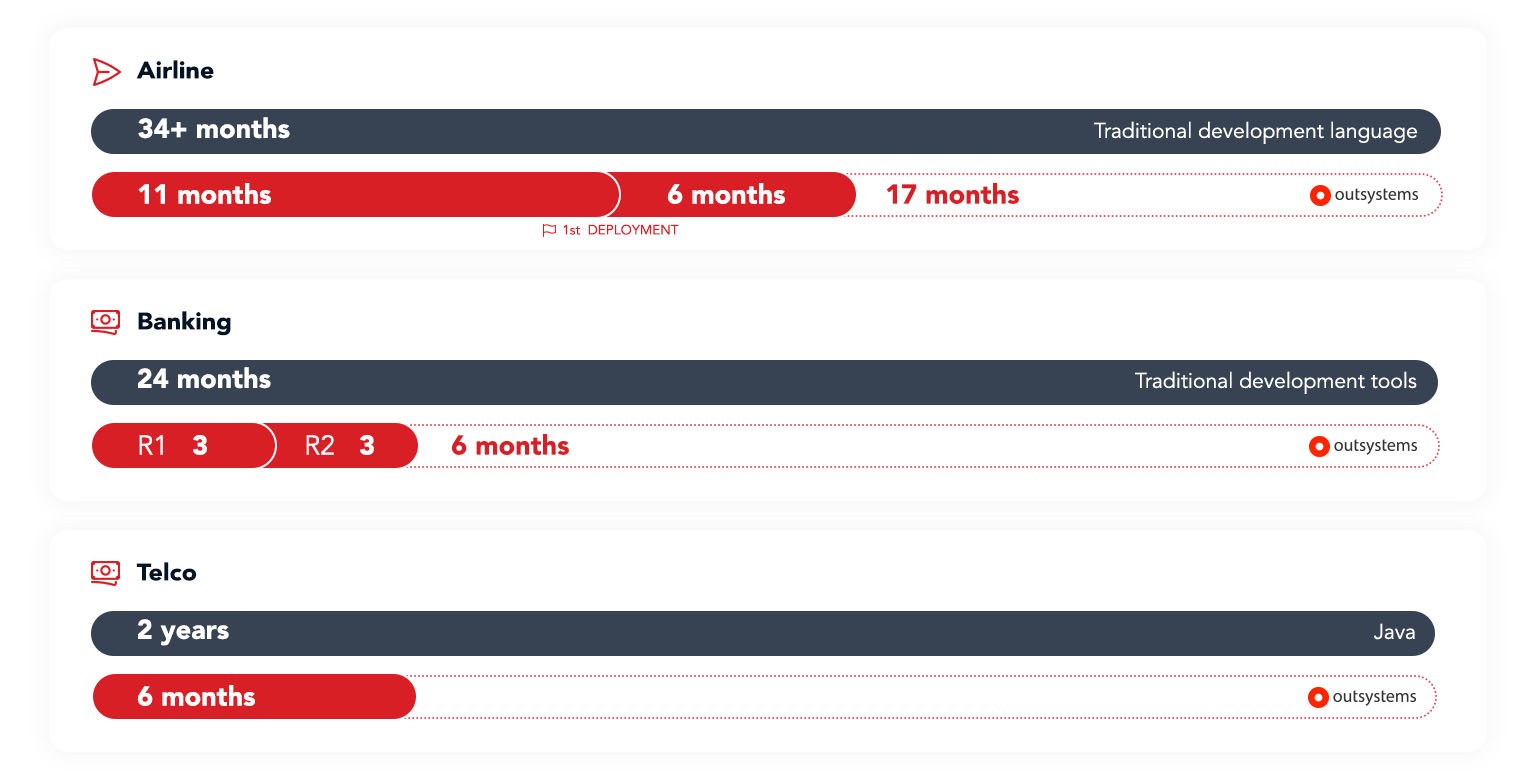Should I shift to another framework?
Microsoft recommends transitioning Xamarin.Forms to their product .NET MAUI, as both share the same .NET codebase. While this framework might seem like the obvious path for developers already familiar with .NET, IT Leaders will still face many of the same development challenges – large teams, high costs and lengthy projects that slow down the time to ship software.
And it’s not just .NET MAUI that faces these challenges. With all cross-platform frameworks – .NET MAUI, React, Flutter etc. – traditional coding underpins everything you do – including integrations with libraries, third-party tools, native features and DevOps workflows.
While there is no license fee for these frameworks, there are unforeseen costs. Traditional coding slows down application development and makes apps complex and expensive to build and maintain. Manual coding languages require advanced programming skills and a highly structured and complex DevOps approach. IT leaders must factor in the significant cost and ongoing challenge of hiring and retaining top talent, including business analysts, UX designers, tech leads, and front-end developers. Ultimately, the success of an application developed with a cross-platform framework hinges on your team’s expertise and ability to deliver.
Further, apps developed by frameworks are often plagued by performance limitations, and a poor user experience due to fragmentation and inconsistencies. Depending on the framework, developers are limited to specific mobile app libraries and progressive web apps (PWAs) are not possible in some frameworks.
These challenges can lead to significant delays and inefficiencies for companies looking to modernise their mobile apps. BCX, an information and communication technologies (ICT) solutions provider, experienced this first-hand when developing a new mobile app:
“We started redeveloping this with Xamarin and delayed a workable mobile solution by a year.”
– Ruben Olivier, Senior Manager of Information Systems, BCX
Choosing the right approach is critical to ensuring faster, more cost-effective application development without the constraints of traditional coding methods.
From complexity to clarity: How a platform approach delivers faster, smarter development
For IT leaders managing burning Xamarin applications, transitioning to a modern technology like OutSystems’ AI-powered low-code platform offers an innovative long-term solution. The platform presents a future-proof alternative, enabling organisations to modernise their applications without the complexities of traditional development.
- Reduces complexity: A platform approach simplifies development across all use cases and ensures a strategic approach to your application portfolio.
Accelerates delivery: Low-code’s visual environment enables app delivery in days, weeks and months, not years. - Lowers development costs: Smaller, highly productive teams reduce development and maintenance costs.
- Leverages AI-powered tools:
- A unique AI tool accelerates code migration from legacy systems such as Xamarin.
- AI mentors improve the entire software development lifecycle (SDLC) – coding, performance, security, and maintenance – reducing technical debt.
- Simplifies staffing: Requires minimal coding expertise, reducing staff recruitment, onboarding and retention challenges.
- Future-proof apps: With low-code, there is no need for future upgrades – the technology allows developers to make changes quickly and easily.
- Enterprise-grade security: Built-in security and compliance features ensure apps are secure from the ground up.
- Seamless integrations: Supports APIs, databases, and legacy systems out-of-the-box.
- Transparent pricing: Subscription-based pricing includes cloud hosting and development tools.
- Established track record: Gartner recognises OutSystems as a low-code market leader due to its extensive experience and success in rapid application development.
With OutSystems, businesses can break free of the constraints of a sunsetting framework and rapidly replace their Xamarin apps—while enhancing agility, streamlining development, and driving innovation.

Customers’ real-world experiences replacing Xamarin with a platform strategy
Migrating from a framework like Xamarin to a modern platform approach with OutSystems can feel like a big leap. But for many organisations, it has proven a game-changer — reducing complexity, accelerating delivery, and future-proofing their applications.
ICT solutions provider BCX turned to OutSystems when Xamarin could not meet their mobile application needs. Ruben Olivier, Senior Manager of Information Systems at BCX expressed the advantages of reducing complexity and speeding up time to value.
“Development is around five times faster on OutSystems compared to traditional coding. We’d need at least nine to 12 developers to accomplish what we’ve been able to do with three. With OutSystems, our three developers delivered a crucial inventory tracking system over a weekend. Today, we support a custom-built ERP system with the same small team.”
– Ruben Olivier, Senior Manager of Information Systems, BCX
“OutSystems automatically updates our apps with new security patches,” says Ruben. “We didn’t have to design for it. And mobile development is much more efficient with single-source development for iOS and Android.”
Another customer, a major regulator, similarly used OutSystems to replace an existing mobile application created with Xamarin. The original field services involved high maintenance costs and experienced performance limitations. It was slow because Xamarin.Forms uses abstraction to render UI components, leading to lag compared to fully native apps. Also, because Xamarin requires knowledge of both .NET (C#) and native platform intricacies, the organisation didn’t have anyone who knew the legacy code well enough to fix it.
In just one month with one developer, the regulator rebuilt the field services mobile application in the OutSystems AI-powered low-code platform. Achieving the same result using a framework based on traditional coding would have taken four to six months. Development time was just 2 weeks. The new solution transforms the user experience through fast UI rendering, a consistent user interface and intuitive navigation, significantly boosting accurate reporting from the field. It also enables seamless integration with mission-critical solutions and other platforms.
Discover OutSystems’ advantages first-hand
Find out how OutSystems can empower your team to replace your Xamarin apps with a modern software development platform that allows them to build smarter – for a fraction of the time, cost and risk of traditional code.

